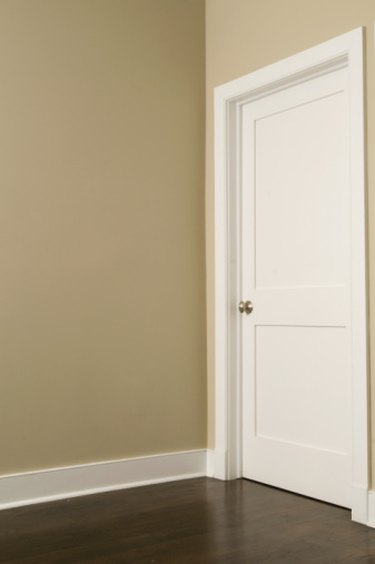
A painted door may stick to a frame for many reasons: too much paint, humidity-induced swelling or an improper fit. A door should be sanded, sealed and painted, and the paint should completely dry before the door is hung. The length of drying time depends on the paint used. You have ways to correct a sticking door and frame if the problem becomes overly bothersome.
Climate-Induced Swelling
Video of the Day
Doors may swell due to weather and season changes. Moisture and heat cause a wood door and/or frame to swell. Cold weather causes a door and/or frame to contract. A swollen door may stick to the frame. If the door has been properly sealed, moisture absorption shouldn't be a problem. An unsealed or old door can absorb moisture, leading to drying and cracking of the wood when the door dries out. If the painted door is sticking to the frame because of climate changes, the door will eventually contract and the sticking will be reduced or eliminated.
Video of the Day
Lubricants
Lubricate doors that stick to the frame to reduce the sticking. Rub the door's top and edges with a dry bar of soap, paraffin wax, petroleum jelly or a household lubricant spray to reduce sticking. Applying a lubricant to the door edges and top is a temporary fix. Sometimes if the door sticks to the frame, there are underlying reasons that may or may not involve the paint; the door could be improperly hung or the hinges may be sagging.
Hinge Adjustments
Thick paint may make a door too big for the frame, and, as a result, the paint will stick to the frame when the door is closed. The door may stick tight enough to warrant yanking to open it or shoving to securely close it. Sometimes sticking paint can be resolved by tightening or adjusting the hinges. First tighten the screws on the hinges, and then inspect them for improvement. Another hinge adjustment involves removing the long screws that slide into the two central hinge parts and replacing them with longer screws. If this doesn't reduce or eliminate the paint sticking, remove the hinges. Fill in the holes on the side with wood putty. Position the door in the frame so there is space between the door top and the frame. On the door, mark where the hinges need to be repositioned. Drill out new holes, and install the hinges in the lower positions.
Sanding or Planing
The sticking painted door top or edges can be sanded or planed. Sometimes there is just too much paint. Sand the door top or edges, depending on where it is sticking. AHC Safe & Lock recommends sanding on the door's hinge side to avoid problems with the latching mechanism. Use a coarse grit, followed by a fine-grit sandpaper to sand away the paint. AHC Safe & Lock website suggests using a wood chisel to remove excess layered paint and then sanding smooth. Planing a door is the process of shaving a small amount of wood away from the door's top, which gives the door room to swing within the frame. Insert cardboard between the door top and the frame, which allows you to see where the door or frame are touching and sticking. Mark the sticking spots on the door with a pencil, and remove the door. Use a jack plane to shave the door in the direction of the corner to the middle over the marked spots. Sand the planed area with fine-grit sandpaper. Examine the planed area with a level to ensure it is even. You can then paint the planed area.